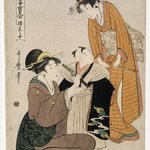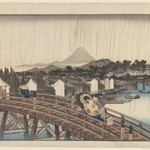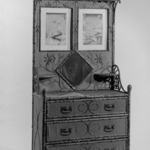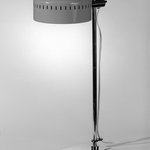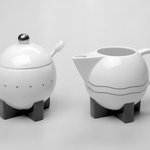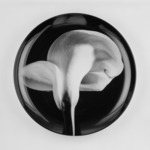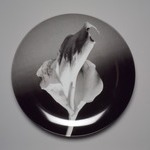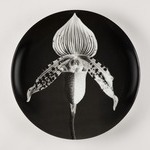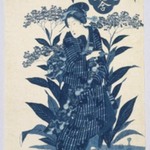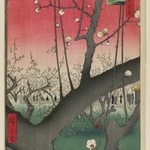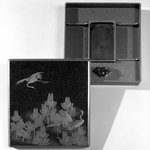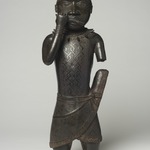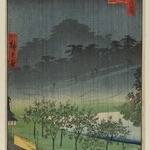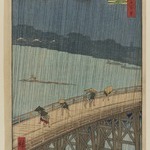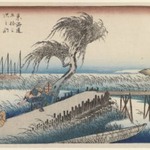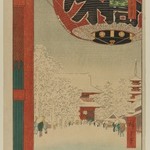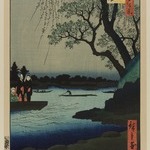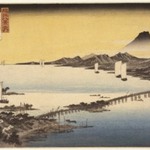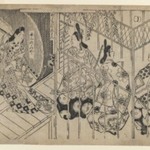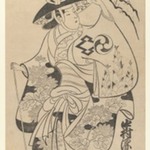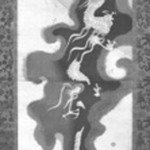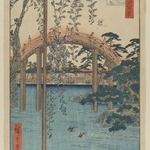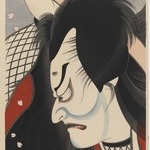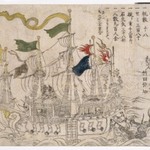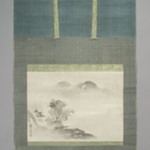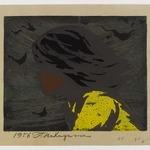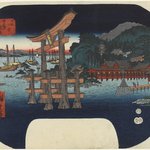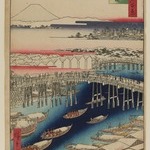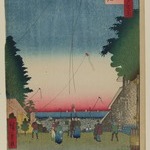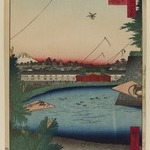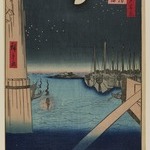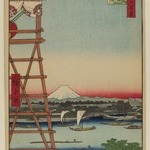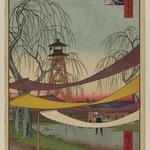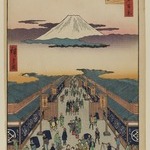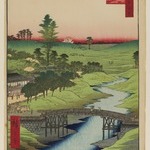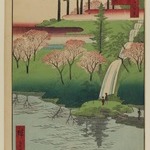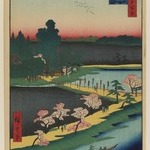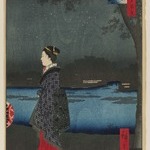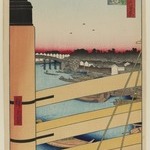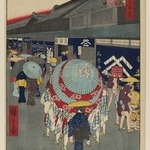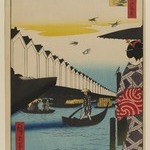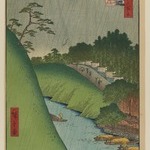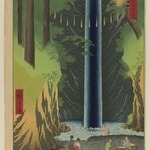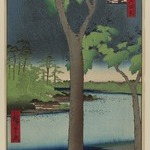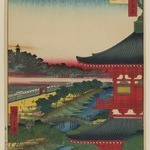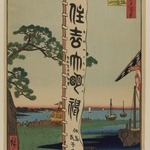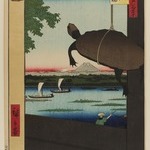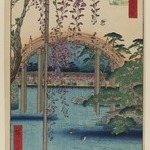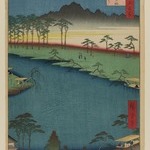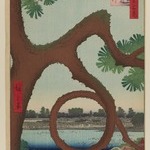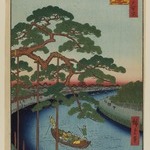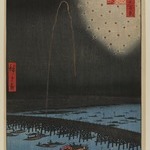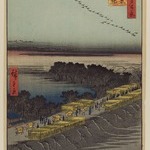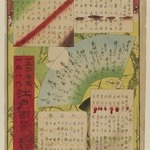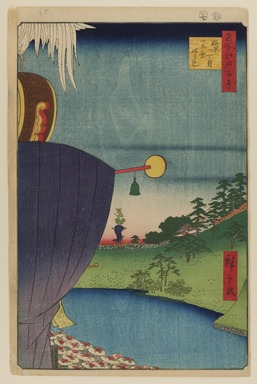
Sanno Festival Procession at Kojimachi l-Chome, No. 51 from One Hundred Famous Views of Edo
Utagawa Hiroshige
Asian Art
Hiroshige here depicts the Sannō Shrine Festival at the symbolic moment when the festival procession enters Edo Castle from the Kojimachi quarter at the very center of the city. The entire procession, which occurred between the tenth and sixteenth days of the sixth month, consisted of more than fifty large and lavishly decorated floats, of which Hiroshige provides only a hint. The two floats here come from two of the city's oldest commoner districts. The float in the distance represents a monkey, while the one in the foreground is an ornamental rooster perched on a large legendary Chinese "drum of admonition" that sage-kings used to summon and chastise their subjects.
MEDIUM
Woodblock print
DATES
7th month of 1856
PERIOD
Edo Period, Ansei Era
DIMENSIONS
Sheet: 14 5/16 x 9 5/16 in. (36.4 x 23.7 cm)
Image: 13 3/8 x 8 3/4 in. (33.9 x 22.2 cm) (show scale)



MARKINGS
No publisher's seal visible, probably lost when left margin was trimmed. Seals in top margin: date seal and censor seal.
SIGNATURE
Hiroshige-ga
COLLECTIONS
Asian Art
ACCESSION NUMBER
30.1478.51
CREDIT LINE
Gift of Anna Ferris
PROVENANCE
Prior to 1930, provenance not yet documented; by 1930, acquired by Anna Ferris of Summit, NJ; 1930, gift of Anna Ferris to the Brooklyn Museum.
Provenance FAQ
CATALOGUE DESCRIPTION
This scene depicts part of the grand festival of the Sanno Shrine. The entire procession consisted of more than fifty large floats, some more than thirty feet high and all lavishly decorated at the expense of the sponsoring parishioners, who are shown wearing flowered hats. The midsummer sun beats down on the blue waters of Benkei Moat and on the high embankment along the southwest side of Edo Castle. In the distance, the festival procession enters the castle grounds from Kojimachi I-chome through Hanzo Gate. From there, it will pass under the personal review of the shogun himself at Inui Gate, an honor shared only by the Kanda Myojin Shrine festival, with which the Sanna festival alternated every year after 1681; the two together were known as the Tenka Festival, "Tenka" (All Under Heaven) being an honorary title for the shogun himself. The float in the distance, that of Minami Denmacho, represents a monkey, messenger of the Sanno god, wearing a gold "eboshi" cap and silk ceremonial gown with a sword in the sash and holding a wand of sacred gohei. In the immediate left foreground is the float of Odenma-cho, the so-called Drum-Bird, a large model of an ornamental rooster with outstretched wings (only the tip is shown here) on a large ceremonial drum. In Japan, the drum symbolized a well-ruled country where its use was no longer required. Historically, the Drum-Bird always led both the Sanno and Kanda Myojin processions, but Hiroshige re-arranged the floats to his own preference.
EXHIBITIONS
MUSEUM LOCATION
This item is not on view
CAPTION
Utagawa Hiroshige (Japanese, 1797–1858). Sanno Festival Procession at Kojimachi l-Chome, No. 51 from One Hundred Famous Views of Edo, 7th month of 1856. Woodblock print, Sheet: 14 5/16 x 9 5/16 in. (36.4 x 23.7 cm). Brooklyn Museum, Gift of Anna Ferris, 30.1478.51 (Photo: Brooklyn Museum, 30.1478.51_PS20.jpg)
IMAGE
overall, 30.1478.51_PS20.jpg. Brooklyn Museum photograph, 2023
"CUR" at the beginning of an image file name means that the image was created by a curatorial staff member. These study images may be digital point-and-shoot photographs, when we don\'t yet have high-quality studio photography, or they may be scans of older negatives, slides, or photographic prints, providing historical documentation of the object.
RIGHTS STATEMENT
No known copyright restrictions
This work may be in the public domain in the United States. Works created by United States and non-United States nationals published prior to 1923 are in the public domain, subject to the terms of any applicable treaty or agreement.
You may download and use Brooklyn Museum images of this work. Please include caption information from this page and credit the Brooklyn Museum. If you need a high resolution file, please fill out our online application form (charges apply).
The Museum does not warrant that the use of this work will not infringe on the rights of third parties, such as artists or artists' heirs holding the rights to the work. It is your responsibility to determine and satisfy copyright or other use restrictions before copying, transmitting, or making other use of protected items beyond that allowed by "fair use," as such term is understood under the United States Copyright Act.
The Brooklyn Museum makes no representations or warranties with respect to the application or terms of any international agreement governing copyright protection in the United States for works created by foreign nationals.
For further information about copyright, we recommend resources at the United States Library of Congress, Cornell University, Copyright and Cultural Institutions: Guidelines for U.S. Libraries, Archives, and Museums, and Copyright Watch.
For more information about the Museum's rights project, including how rights types are assigned, please see our blog posts on copyright.
If you have any information regarding this work and rights to it, please contact copyright@brooklynmuseum.org.
RECORD COMPLETENESS
Not every record you will find here is complete. More information is available for some works than for others, and some entries have been updated more recently. Records are frequently reviewed and revised, and we welcome any additional information you might have.
